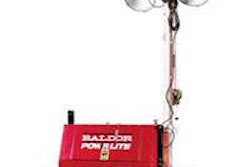by Tina Grady Barbaccia
The visibility of highway workers’ garments — or lack thereof — was put to the test as four cars of editors, including Better Roads, drove around 3M’s test track at dusk and after dark and were given the task of identifying four people on the roadside. The test track had several simulations set up, including an ambulance scene and a nighttime construction scene to provide similar conditions to what drives may experience while driving on the highway.
As we drove at construction zone speeds around the test track, I missed the person wearing a plain white T-shirt and a safety vest with reflective material on it the first two times around the track. The exercise showcased that drivers have a difficult time seeing highway workers in what is often considered safety garments. The actual distance before either worker was visible to me the third time around the track was about 50 feet — not allowing much response time to make adjustments in driving. Add to that talking on a cell phone, listening to the radio or eating something in the vehicle, and the response time is even more truncated.
As a nighttime runner, this really made me think. Those bright yellow safety vests with strips on them really aren’t all that effective after all. I thought I was safe. So did many of the highway workers. But with new ANSI regulations in effect, 3M is working on a new retroreflective safety garments that are reflective all the way around the body – 360 degrees – from all angles at key points.
Going around the test track, the 360-degree retroreflective full-boday garments were easily identifiable at distances well beyond several hundred feet instead of the limited visibility of a reflective vest. Stripes on the 360-degree garments go completely around the wrists, elbows, the bottom of the garment, and the mid-section. There are also reflective stripes that run from the shoulder to the waist, where the stripe intersects with the one that runs around the mid-section from front to back. This provides what’s known as “active lighting.”
“Adopting the lessons learned in recent years will help make roads safer for everyone,” said Federal Highway Administrator Victor Mendez in a press release.
 Active lighting grealty enhances the visibility of safety garments.
Active lighting grealty enhances the visibility of safety garments.By requiring better pavement markings which can increase bike lane safety, and extending walk times for pedestrians at crosswalks, the updated MUTCD furthers the “complete streets” concept – an effort long championed by the FHWA to ensure roads accommodate all types of travel, not just automobiles.
Among the other new provisions in the MUTCD are the following:
• Replacing highway signs with brighter, larger and more legible ones that are easier to understand at freeway speeds. States will begin using the newer signs as existing ones wear out.
• Adding different lane markings for lanes that do not continue beyond an intersection or interchange to give drivers more warning that they need to move out of the lane if they don’t intend to turn.
• Expanding the use of flashing yellow arrow signals at some intersections to give a clearer indication that drivers can turn left after yielding to any opposing traffic.
• Changing the formula used to calculate crosswalk times to give walkers more time.
• Identifying electronic toll collection lanes with purple signs – the first time purple has been sanctioned for use on highway signs.
• Adding overhead lane-use control signs to reduce confusion among drivers in unfamiliar multi-lane roadways.
For an overview of the new rules and recommendations, visit http://mutcd.fhwa.dot.gov.
–by Tina Grady Barbaccia











